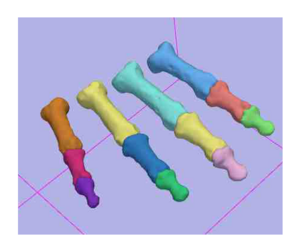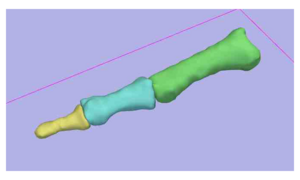Difference between revisions of "EM Segmentation For Orthopaedic Applications"
From NAMIC Wiki
| Line 12: | Line 12: | ||
**Validation assessed using the laser scanning of the index finger (proximal, middle, and distal) phalanx bones in five specimens | **Validation assessed using the laser scanning of the index finger (proximal, middle, and distal) phalanx bones in five specimens | ||
* Work is underway to develop a Slicer2.7 tutorial for this segmentation ([[Image:Draft_EM_Segment_Tutorial_9_12.pdf|Draft Copy]]) | * Work is underway to develop a Slicer2.7 tutorial for this segmentation ([[Image:Draft_EM_Segment_Tutorial_9_12.pdf|Draft Copy]]) | ||
| + | |||
| + | '''Results:''' | ||
| + | |||
| + | Finger Phalanx Segment Average Relative Overlap | ||
| + | Index (14 subjects) Proximal 0.87 | ||
| + | Medial 0.80 | ||
| + | Distal 0.70 | ||
| + | Index (2 subjects) Proximal 0.87 | ||
| + | Medial 0.76 | ||
| + | Distal 0.60 | ||
| + | Middle (2 subjects) Proximal 0.79 | ||
| + | Medial 0.74 | ||
| + | Distal 0.71 | ||
| + | Ring (2 subjects) Proximal 0.76 | ||
| + | Medial 0.82 | ||
| + | Distal 0.80 | ||
| + | Pinky (2 subjects) Proximal 0.70 | ||
| + | Medial 0.73 | ||
| + | Distal 0.72 | ||
'''To Do:''' | '''To Do:''' | ||
* Evaluate the Slicer3 EM Segmentation Module | * Evaluate the Slicer3 EM Segmentation Module | ||
| + | **Example datasets sent to Brad Davis for evaluation of the Slicer3 EM Segmentation for non-neuro applications | ||
| + | **Discussion of the results will take place at 2008 AHM | ||
* Update the the tutorial to support the Slicer3 Workflow | * Update the the tutorial to support the Slicer3 Workflow | ||
| + | **Summer of 2008 - Tutorial will be developed by Austin Ramme | ||
* Determine if registration tools in Slicer are adequate for this work. | * Determine if registration tools in Slicer are adequate for this work. | ||
Revision as of 20:24, 6 January 2008
Home < EM Segmentation For Orthopaedic ApplicationsObjective:
- To utilize the Slicer3 Expectation Maximization Algorithm for segmentation of the phalanx bones of the hand.
Progress:
- We have utilized the Slicer2.7 EM Segmentation Module for segmentation of the phalanx bones
- Registration was performed outside of Slicer using ITK registration algorithms that are available in the IaFeMesh software. This includes Thin plate spline, B-Spline and rigid registration algorithms.
- Probability map information was created from a single subject used as the atlas image and filtered using a Gaussian filter.
- Initial evaluation has been performed
- Reliability assessed on fourteen specimens that also had the index finger segmented, and two specimens that had the index, middle, ring and little fingers manually segmented
- Validation assessed using the laser scanning of the index finger (proximal, middle, and distal) phalanx bones in five specimens
- Work is underway to develop a Slicer2.7 tutorial for this segmentation (File:Draft EM Segment Tutorial 9 12.pdf)
Results:
Finger Phalanx Segment Average Relative Overlap Index (14 subjects) Proximal 0.87 Medial 0.80 Distal 0.70 Index (2 subjects) Proximal 0.87 Medial 0.76 Distal 0.60 Middle (2 subjects) Proximal 0.79 Medial 0.74 Distal 0.71 Ring (2 subjects) Proximal 0.76 Medial 0.82 Distal 0.80 Pinky (2 subjects) Proximal 0.70 Medial 0.73 Distal 0.72
To Do:
- Evaluate the Slicer3 EM Segmentation Module
- Example datasets sent to Brad Davis for evaluation of the Slicer3 EM Segmentation for non-neuro applications
- Discussion of the results will take place at 2008 AHM
- Update the the tutorial to support the Slicer3 Workflow
- Summer of 2008 - Tutorial will be developed by Austin Ramme
- Determine if registration tools in Slicer are adequate for this work.
Key Investigators:
- Iowa: Austin Ramme, Nicole Grosland, and Vincent Magnotta
Links:
Figures:

